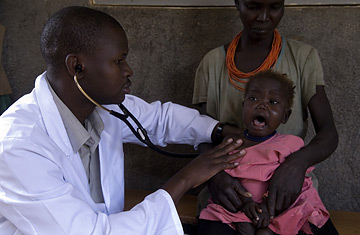
Dr James Lemukol checks a girl at St. Kizito Hospital feeding ward.
It's feeding time at St. Kizito Hospital's malnutrition program. Children have been weighed and measured on the terrace, as they are every weekday morning, and now their weak crying and occasional shrieks fill the air. Mothers dribble formula into their infants' mouths, while older and stronger kids munch on a fortified peanut paste donated by UNICEF. "This one," says a nurse, pointing to a boy who scampers past her in oversized shorts, "you can't imagine the state in which he arrived. He couldn't even stand."
In the drought-stricken Karamoja region of Uganda — an east African country slightly smaller than Oregon, just west of Kenya — St. Kizito is where malnourished children are brought to get better. Locals say this hospital in the town of Matany is the only good one for perhaps 100 miles: no doubt that's one reason why the therapeutic feeding center, as the malnutrition program is called, houses 33 young patients in its one room with eight cots. Inside, a handful of mothers sit and feed the children who are too weak to play, or even to cry.
Between July 2007 and early May this year, hospital superintendent Dr. James Lemukol saw nearly 300 children at the center, and about 60 of them died. But Lemukol maintains some optimism. "The outcome of these children, provided they come on time, is really good," he says. To survive, all they need is to arrive at St. Kizito before an opportunistic infection sets in — more often than not, they already have malaria or diarrhea — and then get enough good food, which the hospital can provide. (St. Kizito is funded mostly by grants and donations from U.N. agencies and private citizens, plus the Ugandan government.) Still, the fight against malnutrition is not as simple as handing out food to the sickest, as Lemukol, 34, who is a native of the region, is well aware.
The key problem for medical staff is that malnutrition is a condition that resembles plague, rather than, say, cancer: its victims suffer en masse, not one at a time. By the time a program like the one at St. Kizito begins receiving patients, odds are good that the food shortage is already severe and widespread. But that means treating one child can put his or her siblings at risk. "I have five other children," says Apukei Santina, sitting on a bench on St. Kizito's terrace on this bright, pleasant Monday morning. She has been at the hospital for the full duration of her daughter's treatment, which the program requires. Most of the children here are still young enough to need constant maternal stimulation — and, crucially, breast milk.
On average, it takes about 28 days before children become healthy enough to go home. Santina has already been here eight weeks; the rest of her family has been left at home with Santina's husband. But he's out all day herding the family cattle and goats, so domestic duties fall to the eldest daughter, who's only 12. Santina lives close enough to the hospital that she can do some casual labor in Matany during the day, then take the money she earns home for her young children. Most women, however, live too far from the hospital, and some must spend weeks away from their families.
At this time of year, that means a mother would miss crop-tending season, when she would normally be weeding. Unless her children are old enough to do the work for her, there will be less food for the family to eat when the next harvest comes in August. "Then maybe she'll have three malnourished kids instead of one," says Lemukol. In his graphs of annual patient data for the center, he has a column labeled "escaped": some mothers, with other hungry children at home, just walk out, pulling their kids out of treatment before they're medically fit to leave.
Santina gently rocks her one-year-old daughter, Alaper. Despite the extended stay at the hospital, Santina says she is grateful. "I appreciate one thing for sure," she says. "My child looks better than when she arrived." Two months ago, Alaper weighed just over half the normal weight for her age. Today she is lively and alert, and watches her mother closely.
Alaper may even have come early enough to avoid any lasting damage. "The greatest impact can be retardation of development," Lemukol says, pointing to another child. This boy is three years old, but his mother still cradles him as if he were a baby. "He's only just able to crawl," says Lemukol. The superintendent pauses to think about this for a moment. "The children can catch up, but it takes time," he says. And time, like food and money, is just one more thing in short supply.
